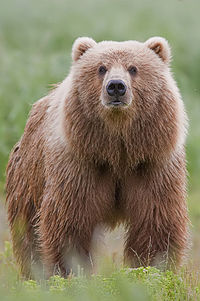Bear (5e Race)

|
|---|
Bear[edit]
Physical Description[edit]

|
|---|
Adult black bears are approximately 4 to 7 feet from nose to tail standing upright, and two to three feet high when on all fours. Males are larger than females. Black bears have rounded faces with small eyes, rounded ears, and a long snout. They also have large non-retractable claws, a large body, a short tail, and shaggy hair. Most black bears are true black in color unlike black bears found in other lands that can be shades of red, brown, or blond. Polar bears are black-skinned but their fur makes them appear white.
History[edit]
Bears are wild beasts that traditionally live in the wilderness and stay to themselves within a den. Occasionally they enter humanoid society, usually via capture. Many a bear has become a sensation for performing parlor tricks whilst being ogled at within cages at circuses and by curious children. Some bears do get treated better in societies where they aren't seen as simple primitives and are allowed to express themselves better, thus allowing them to become adventurers and such. They often are up for higher as fishermen or hunters due to their ability to use their natural instincts and navigate terrains like forests and even mountains.
Most bears in known society are in circuses, particularly those run by humans. Royalty was known to enjoy a good party or two with a bear that did tricks. Those bears were subsequently mistreated by guests and jeered at for being big and slow dullards compared to humanoids. Those who escape often cannot easily return to the wild and so are stranded. Many abhor humans, though escapees will usually join anyone who shows kindness and provides food. Some eventually make it back to the wild while others stay in the cities and become civilized humanoids. There is a chance the bear who returns to the wild may be attacked by other bears due to having been marked by human scent.
Society[edit]
Bears are generally solitary creatures, except for sows caring for their dens of cubs. Adult bears may be seen together during the summer breeding period and occasionally yearling siblings will remain together for some time. Bears may also gather at places with abundant food sources, though they do not interact at a deep level of communication save for territorial purposes. Bears are not mean or malicious and can be observed as being curious as well as adventurous. Bears are normally shy, retiring animals that have very little desire to interact with humans. Unless they are forced to be around humans to be near a food source, they usually choose to avoid humans.
Bears who encounter others marked by humans will reject them. The hatred of humans has grown in recent years not only due to captivity but also developments that threaten the bears' natural habitats. Bears value self-sufficiency, which gets harder to accomplish as their resources get allocated away. Cubs are expected to grow up and leave the den to find their own fortunes. As a result of depleting natural ways of life, many now try to integrate into humanoid society for employment and such.
Portrayals[edit]
Aside from being entertaining sideshow staples, bears are also generally portrayed as the animal epitome of laziness. They hibernate for long winter periods in the wild and sift through human trash for food sometimes, making them appear less industrious than other animals. Due to this association with the sin of sloth, bears are often not favorable as hires, despite their capability. Religious bodies where sloth is a sin also reject bears. Other institutions paint bears as symbols of strength and durability.
Bear Names[edit]
Bears do not name themselves or each other but will accept being named by friendly humanoids. They tend to be named either for war or as pets, which are usually ignorant of gender.
War Names: Slasher, Argos, Ajax
Pet Names: Fuzzy-Wuzzy, Floofer, Slobbers, Sir Bearington, Trinket
Bear Traits[edit]
| Simply a bear Ability Score Increase. Your Strength score increases by 2, and your Constitution score increases by 1. Age. Bears live short lives of up to about 20 years. Bears reach maturity at age 2. Alignment. Bears are very simple creatures. As such, they tend toward neutral. Size. Bears are 4-5 ft. long and have a shoulder height of about 3 feet. Your size is Medium. Speed. Your base walking speed is 30 feet. |
| Bear Body. As a bear, your creature type is beast. Additionally, you cannot don traditional armor and must use barding. You have disadvantage on attack rolls using weapons not designed for bears. While moving, you must be on four legs. When you stand upright, you cannot use any movement speed. To shift to your hind legs from quadruped stance and vice versa requires a bonus action. |
| Bear Claws. Because of your claws and sturdy legs, you have a climb speed of 30 feet. Your claws are natural weapons, which you can use to make unarmed strikes. If you hit with them, you deal slashing damage equal to 1d4 + your Strength modifier, instead of the bludgeoning damage normal for an unarmed strike. |
| Keen Smell. You have advantage on Wisdom (Perception) checks that rely on smell. |
| Powerful Build. You count as one size larger when determining your carrying capacity and the weight you can push, drag, or lift. |
| Languages. You have a basic understanding of simple Common (ex. "stay," "follow," "kill,") and can communicate through rudimentary charades. Additionally, you can speak with bears and can speak for the purposes of casting spells with verbal components. |
Random Height and Weight[edit]
| Base Height |
Height Modifier* |
Base Weight |
Weight Modifier** |
|---|---|---|---|
| 4′ 9'' | +1d6 | 200 lb. | × (10) lb. |
|
*Height = base height + height modifier | |||
Back to Main Page → 5e Homebrew → Races
